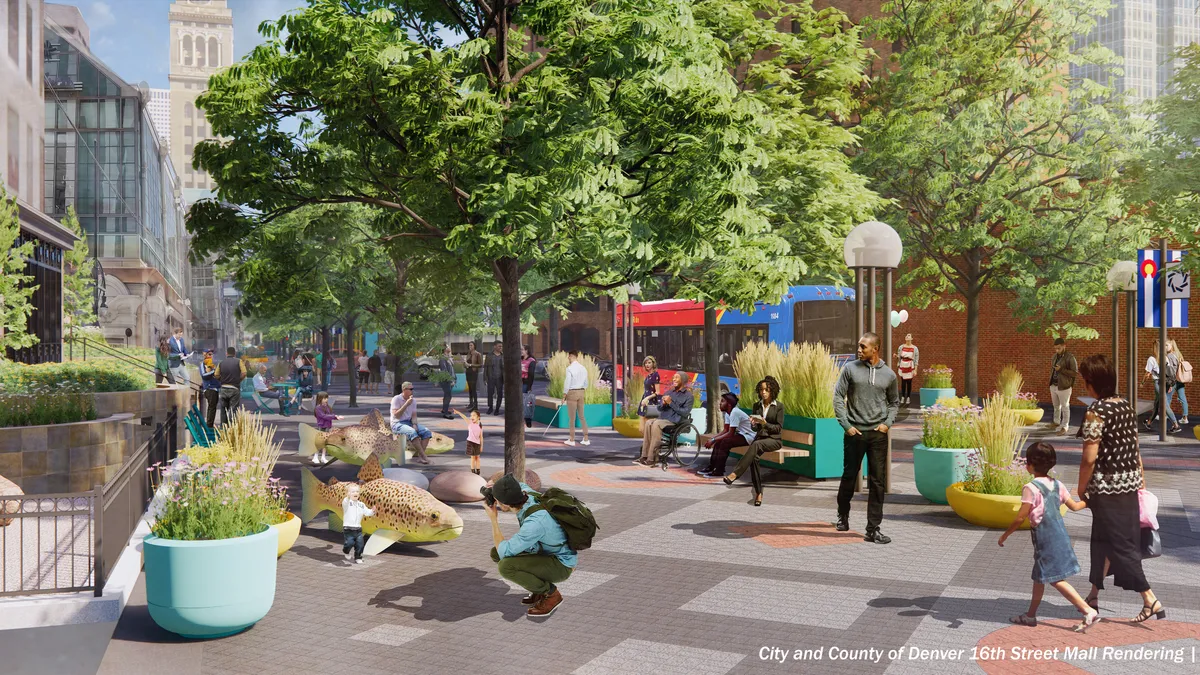As in many cities throughout the U.S., Denver’s downtown still hasn’t fully recovered from the financial impacts of the COVID-19 pandemic.
In 2019, the downtown was bustling with vibrant businesses, business travelers, conventioneers and people visiting the Mile High City for leisure. Conventions are starting to return to the business district, as are tourists and business travelers, said Deborah Cameron, chief business development officer for the city and county of Denver. Still, workers have not fully returned to the office, she said.
Pedestrian traffic in the business district in May 2022 was down 31% compared to May 2019, the nonprofit Downtown Denver Partnership found. A survey of major downtown employers in April and May 2022 by the nonprofit indicated that three in four offered employees hybrid work options. In its recently released report, the Downtown Denver Partnership also found that office vacancy rates in the second quarter of 2022 reached 21%, the highest since at least 2017.
However, Denver is working to bring back that pre-pandemic vibrancy.
City and county leaders are trying to “re-imagine our downtown area,” said Cameron. “We want to turn it into a complete neighborhood.” That includes grocery stores and local residents in the upper downtown district, like what can be found in the lower downtown area, she said.
Denver is one of a number of cities, including San Francisco, that are actively rethinking their downtowns to meet post-COVID work patterns.
Part of that effort includes transitioning some commercial space into residential. Commercial vacancies have been prevalent in most U.S. cities since the start of the pandemic, which, despite a number of cost and logistical challenges, has led to an explosion in office-to-housing conversion projects, Multifamily Dive reported.
Cameron said two or three buildings in Downtown Denver are going through the planning process. According to news reports, developers and city planners are eyeing even more.
The city has also utilized federal COVID recovery funds to try and boost foot traffic downtown. This week, the Denver City Council signed off on a $2.4 million contract with the Downtown Denver Partnership and the Downtown Denver Business Improvement District to support the promotion of various events and festivals like Taste of Colorado this weekend, said Cameron. The money, coming from the American Recovery Plan Act, will also continue efforts to support existing businesses and pop-up retailers, improve public safety and upgrade technology at its entrepreneurship hub to help bring new startups, she said.
The city previously used $400,000 in ARPA funds in April to promote its hotels, restaurants, retailers, museums and attractions, Downtown Denver Partnership stated.
“We are positioned to continue making downtown energetic, colorful, exciting, and fun again,” said Kourtny Garrett, president of the Downtown Denver Partnership in a statement. “Urban centers are evolving, and we need to support this change with bold ideas and big investments to build consumer confidence and create moments of serendipity, which is exactly how these funds will be directed.”
The city is also completing a $150 million overhaul of its 16th Street Mall, a more than mile-long pedestrian space closed off to all vehicular traffic — except for public transit shuttles — that is flanked by businesses, retailers and restaurants. The project will bring public transit lanes to the center of the mall, increase the sidewalk area to allow restaurants to have expanded outdoor seating, provide more green canopy and install play areas for kids and families, said Cameron.
Denver officials also intend to start the process of renewing the city’s Downtown Area Plan next year, said Cameron. The existing version was created in 2007 and amended in 2018.
“By the time this planning process kicks off next year, hopefully, we’ll have a better sense of where things are going,” said Cameron. “There’s been a lot of disruption and noise in the pandemic and we're all waiting to see what the next phase looks like.”












